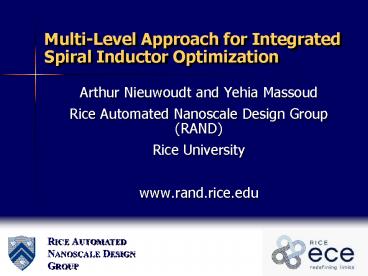MultiLevel Approach for Integrated Spiral Inductor Optimization - PowerPoint PPT Presentation
1 / 14
Title:
MultiLevel Approach for Integrated Spiral Inductor Optimization
Description:
Arthur Nieuwoudt and Yehia Massoud. Rice Automated Nanoscale Design Group ... Lw: desired inductance : tolerance. Design ... to a class of pattern search ... – PowerPoint PPT presentation
Number of Views:40
Avg rating:3.0/5.0
Title: MultiLevel Approach for Integrated Spiral Inductor Optimization
1
Multi-Level Approach for Integrated Spiral
Inductor Optimization
- Arthur Nieuwoudt and Yehia Massoud
- Rice Automated Nanoscale Design Group (RAND)
- Rice University
- www.rand.rice.edu
RICE AUTOMATED NANOSCALE DESIGN GROUP
2
Spiral Inductors A Key to System-on-Chip
Integration
- Analog synthesis crucial for fully automated
system-on-chip (SoC) design - Integrated spiral inductors key SoC component
- Utilized in key Analog/RF circuits including
LNAs, VCOs, and on-chip filters - Quality factor limits circuit performance
- Integrated inductor modeling is complex
- Design space complexity limits the effectiveness
of ad hoc design techniques
- Efficient inductor optimization crucial
- Maximize inductor performance (Q, L, area)
- Efficiently enable fully automated SoC design
3
Previous Optimization Techniques
- Exhaustive Enumeration Niknejad and Meyer, 1998
- Enumerate over a range of possible parameters
- Computationally inefficient
- Geometric Programming Hershenson et al., 1999
- Convex optimization technique that exploits
models consisting of geometric functions - Requires specific model formulation based on
monomials or posynomials
- Sequential Quadratic Programming (SQP) Zhan and
Sapatnekar 2004 - General nonlinear constrained convex optimization
Need Generalized Inductor Optimization
4
Inductor Optimization Problem Formulation
Maximize
Subject to
Bound Constraints on (n,s,w,d)
Lw desired inductance ? tolerance
- Also optimizes over other constraints
- Self-resonant frequency
- Parasitic capacitance
5
Design Space Characterization
- Consider inductor turns (n) as continuous
variable - Avoids expensive mixed-integer nonlinear
optimization techniques - Provides more flexibility in the design domain
- Produces designs with larger quality factors
- Must explore design space convexity to
efficiently optimize the inductor
6
Quality Factor
Initial Start Point W 12 D 325 Optimized
Quality Factor 0.2
Initial Start Point W 5 D 240 Optimized
Quality Factor 2
7
Non-Convex Effective Inductance Constraint
- Effective inductance
- Positive in inductive region
- Zero at self-resonance frequency
- Negative in capacitive regime
- Can impact the location of feasible values
8
Multi-Level Inductor Optimization
- The idea combine global optimization with convex
local optimization to exploit design space
properties - Want global optimization algorithm that
approaches the neighborhood of the optimal value
quickly - Statistical methods may not quickly approach the
neighborhood of the optimal value - Simulated annealing and genetic algorithms
require significant computational effort - May not approach optimal value initially due to
statistical nature - Need deterministic global optimization algorithms
- Enumeration
- Pattern search algorithms
9
Mesh-Adaptive Direct Search
- Belongs to a class of pattern search algorithms
- Intelligently constructs and refines a set of
possible design points (mesh) - Algorithm executes 2 steps at each iteration
- Search step Searches mesh using deterministic
sampling - Poll step If search is unsuccessful, algorithm
polls nearby mesh points - Based on results in search and poll steps, the
mesh is either coarsened or reduced - Monotonically converges to optimal values
C. Audet and J.E. Dennis, 2004.
10
Optimization Methodology
- Global Phase
- Can use Mesh-Adaptive Direct Search (MADS)
- Does not require convexity
- May use several start points for better
performance
- Local Phase
- Utilizes SQP to exploit local convexity
- Rapidly converges to optimal value
11
Comparison of Optimization Techniques
- Single-level approaches
- Enumeration over uniform grid
- Sequential Quadratic Programming
- 200 runs with random start points
- Calculated the average number of function
evaluations to reach within 95 of optimal
quality factor - New multi-level approach
- Mesh-Adaptive Direct Search coupled with SQP
- Selected Design Problems
Examples
12
Comparison with Existing Techniques
16 nH, 4 GHz, Low ?
10 nH, 2.4 GHz, High ?
16 nH, 4 GHz, Low ?
10 nH, 2.4 GHz, High ?
35x Speedup Over Enumeration
25x Speedup Over Convex
13
Conclusions
- Multi-level approach for spiral inductor
optimization efficiently optimizes inductor
designs - Does not require convex objective or constraint
functions - Appropriate for use with any general inductor
model - Number of turns treated as continuous variable
- Avoids mixed-integer optimization
- Generates higher quality factors
- Will enable the efficient automated design of
integrated spiral inductors in SoC
14
Comparison with Other New Multi-Level Methods
Example 1
Example 1
Example 3
Example 3
19x Maximum Speedup Over Enumeration Convex

